 Promotional art for THE LAST MESSAGE - UMIZARU, the Japanese blockbuster now playing both 2D and 3D versions. Photo courtesy of Toho Co., Ltd. © 2010 Fuji Television Network, ROBOT, Pony Canyon, Toho, Shogakukan, Team Agent FNS27 Inc.
Promotional art for THE LAST MESSAGE - UMIZARU, the Japanese blockbuster now playing both 2D and 3D versions. Photo courtesy of Toho Co., Ltd. © 2010 Fuji Television Network, ROBOT, Pony Canyon, Toho, Shogakukan, Team Agent FNS27 Inc.Toho Sails to the Top of the Box Office with a New 3D Chapter in Their Spectacular UMIZARU Series Author: Kevin Grays Official Movie Site: umizaru.jp
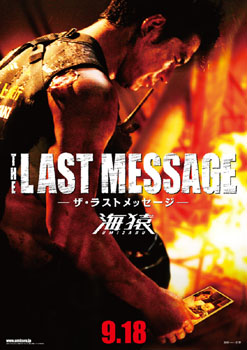 Advance poster art for the film featuring star Hideaki Ito. Photo courtesy of Toho Co., Ltd. © 2010 Fuji Television Network, ROBOT, Pony Canyon, Toho, Shogakukan, Team Agent FNS27 Inc.
Advance poster art for the film featuring star Hideaki Ito. Photo courtesy of Toho Co., Ltd. © 2010 Fuji Television Network, ROBOT, Pony Canyon, Toho, Shogakukan, Team Agent FNS27 Inc.Following the overwhelming international success of James Cameron`s AVATAR (2009), the Japanese film industry has made a bold move into the waters of 3D with its own challengers. Among the top 10 films in Japan in 2010 as of August, the leading four were grand scale 3D American productions with AVATAR winning the war of these foreign invaders. Domestic box office receipts in the first six months of this year, according to The Motion Pictures Producers Association of Japan, improved by over 1.5%. Theaters in Japan saw such a positive turnaround in the increase of audience numbers— despite the greater price in tickets for these films— that the new 3D movie technology made headline news across the nation. Toho Studios, producers of the worldwide famous Godzilla films, has held the number one place in annual domestic box office profits for seven consecutive years. Cautious about using the new technology for converting their movies into 3D, they were surprised like so many others in early August by Toei Company`s 3D hit, KAMEN RIDER DOUBLE FOREVER: A TO Z - THE GAIA MEMORIES OF FATE. This 3D Masked Rider movie pushed Japanese live-action movies back into the top 10 most popular films in Japan. Toho Studio Executive Urai Toshiyuki gave comment that, "We might try 3-D films if they are sure to maximize our profits. The production costs of 3D movies are estimated at 50% higher expenditures than for a regular movie, although that can vary depending on actual production." Japanese studios, not convinced that revenue from the profit of such home-made productions would cover the additional cost regardless of Japanese involvement in the reinvention of the technology, cameras, etc., saw Toei take the lead with their successful KAMEN RIDER DOUBLE production. Studio executive Minami Ichikawa, however, said, "The success of AVATAR was the game-changer." So Toho studios made the decision to experiment with the release of the latest installment in their epic UMIZARU series. Originally filmed in a 2D format, THE LAST MESSAGE - UMIZARU (Za Rasuto Messeji: Umizaru) was upgraded into 3D for select releases in cinemas across Japan. And it did not take long at all for LAST MESSAGE to take the very top box office crown away from the competition. With a September 18, 2010 release, the first nine days saw over 2.1 million admissions that sent profits racing beyond $38.6 million. Shown in both traditional 2D and new technology 3D versions, 68.7% of audiences opted for the more expensive 3D experience.
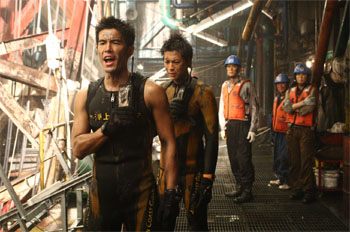 Senzaki and the Special Rescue Team risk their lives to save the survivors of a disaster aboard an offshore natural gas rig. © 2010 Fuji Television Network, ROBOT, Pony Canyon, Toho, Shogakukan, Team Agent FNS27 Inc.
Senzaki and the Special Rescue Team risk their lives to save the survivors of a disaster aboard an offshore natural gas rig. © 2010 Fuji Television Network, ROBOT, Pony Canyon, Toho, Shogakukan, Team Agent FNS27 Inc.UMIZARU began as a manga serialized by Shogakukan in the pages of the weekly Young Sunday back in 1998. The comics ran through 2001. Cartoonist Shuho Sato, known for his harsh criticisms of the Japanese publishing industry and debates on the decline of paper publications in the digital age, drew Umizaru for several years. The original idea and research for the saga are often credited to Yoichi Komori. In the stories of shipwreck rescues and incidents at sea where Japan`s Coast Guard plays a major role, the heroism of Officer Daisuke Senzaki takes center stage. True activities and accidents encountered by the Japanese Coast Guard inspired the characters and their adventures in the strips. Over 4 million copies of the collected comics sold throughout Japan as they were adapted into two NHK high definition specials and a television drama. A sharp rise in the number of applications to Japan`s Coast Guard were credited to the popularity of the series. Once known as The Maritime Safety Agency (Kaijo Hoan-cho), the Japan Coast Guard employs some 12,000 personnel to protect the coastal waters of Japan. Founded in 1948 following the 1945 surrender of Japan which left The Imperial Japanese Navy incapable of operating, Japan`s Coast Guard grew under the oversite of The Ministry of Land, Transportation and Tourism, and Infrastructure. To ensure the safety and security of the Japan Sea, routine patrols through the waters near Takeshima, The Northern Territories off the northeast coast of The Nemuro Peninsula of Hokkaido, and The Senkaku Islands, include countermeasures against piracy, terrorism, illegal immigration, smuggling of forbidden cargo, the surveillance of illegal operations by non-Japanese fishing vessels, and dealing with unlawful acts by foreign oceanographic research vessels.
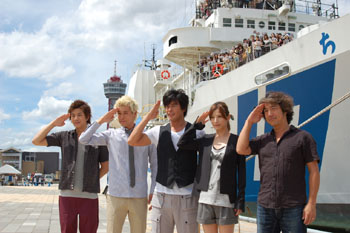 The cast attends a publicity event for THE LAST MESSAGE. © 2010 Fuji Television Network, ROBOT, Pony Canyon, Toho, Shogakukan, Team Agent FNS27 Inc.
The cast attends a publicity event for THE LAST MESSAGE. © 2010 Fuji Television Network, ROBOT, Pony Canyon, Toho, Shogakukan, Team Agent FNS27 Inc.The boundaries of Patrol are not without controversy. Among other nations, China and Taiwan sometimes dispute the regions of territory. Japan tries to work within the boundaries of an often tense allegiance with the U.S. beneath the guidance of national surrender and sovereignty as outlined by their constitution since the Allied Occupation following World War II, bringing them into conflict with such neighbors as North Korea. Two primary special forces units are maintained; the Special Security Team (SST - Tokushu Keibi Tai) and the Special Rescue Team (SRT - Tokushu Kyunan Tai). 455 watercraft and 73 aircraft, including 46 helicopters, comprise a fleet of rescue and patrol craft. Coast Guard Museums were dedicated in Hiroshima prefecture, and Kanagawa prefecture in Yokohama. To become officers, Japanese cadets train at the Japan Coast Guard Academy with headquarters in Kure, Hiroshima prefecture. "Umizaru" — or "Sea-Monkey"— is somewhat insulting nickname given to the rescue diver trainees by the people of Kure. The name is meant to reflect the trinees` excessive and often disorderly conduct when off duty.
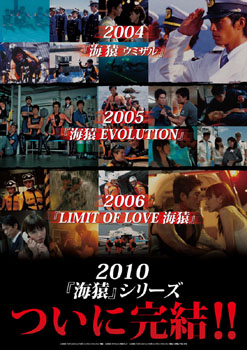 Advertisement for the entire UMIZARU film and TV series. © 2010 Fuji Television Network, ROBOT, Pony Canyon, Toho, Shogakukan, Team Agent FNS27 Inc.
Advertisement for the entire UMIZARU film and TV series. © 2010 Fuji Television Network, ROBOT, Pony Canyon, Toho, Shogakukan, Team Agent FNS27 Inc.Licensed by Toho and the Fuji Television Network, UMIZARU became a hit movie in 2004. Directed by Eiichiro Hasumi, the film unveiled the story of 14 coast guard recruits as their 50 day training course to become the special rescue divers also exposed personal insecurities, drunkenness, and their sufferings while facing the dangers of underwater search and rescue operations. More friendships and love developed after the brutal training in the exciting UMIZARU EVOLUTION, a television series directed by Hasumi that ran for 11 episodes from July 5 to September 13, 2005 on Fuji TV. The UMIZARU team struck box office gold with their second movie LIMIT OF LOVE: UMIZARU (Rimitto obu Rabu Umizaru, aka UMIZARU 2: TEST OF TRUST). This film became the most successful motion picture in the country for 2006, and also earned the 2nd highest box office gross ever for a Japanese live action movie. Trapped in a defining disaster in LIMIT OF LOVE, Senzaki learns to live with the cruel reality that even he cannot always save everyone. Daisuke Senzaki has been consistently played throughout the UMIZARU productions by actor Hideaki Ito, star of SUKIYAKI WESTERN DJANGO (2007), 252: SIGNAL OF LIFE (252: Seizonsha Ari, 2008), and KAMUI (Kamui Gaiden, 2009). Ito has a divemaster`s license from PADI (Professional Association of Diving Instructors) and is an avid scuba diver, skier and snowboarder. In the most recent continuation of the UMIZARU epic, Senzaki joins officer Tetsuya Yoshioka (Ryuta Sato) on a special rescue mission with engineer Hiroshiichiro Sakuragi (Masaya Kato) to save the survivors of a natural gas plant accident aboard the rig, the Regalia. When they are all trapped by an explosion, the added complications of an approaching typhoon force the High Command Office of the Japanese Coast Guard to struggle against the odds in finding a way to rescue the divers. Government officials put their national interests first above the concerns of the trapped men and their waiting families as politics and human emotion clash in THE LAST MESSAGE - UMIZARU. When The Fuji Television Network asked Toho to consider converting parts of the new movie into the new 3D format to enhance excitement in the dramatic action sequences, the studio finally reached an agreement and conceded to the necessary production budget increase. Already benefiting from the incredible cinematography of Akira Sako as he filled the post of Director of Photography, LAST MESSAGE proved the viability of Toho Studios to take charge in the future production of spectacular cinema. "Next year and beyond we have several 3D projects, live-action and animated films..." was a recent statement from the studio.
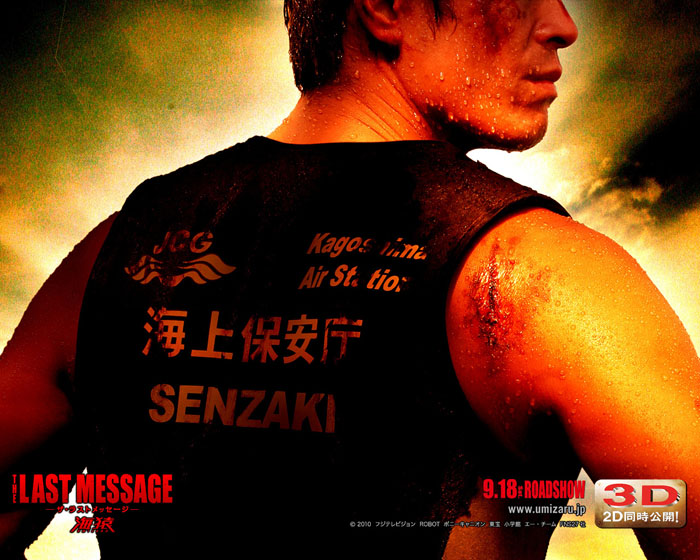 Another promotional design for the film featuring Hideaki Ito as Daisuke Senzaki. Photo courtesy of Toho Co., Ltd. © 2010 Fuji Television Network, ROBOT, Pony Canyon, Toho, Shogakukan, Team Agent FNS27 Inc.
Another promotional design for the film featuring Hideaki Ito as Daisuke Senzaki. Photo courtesy of Toho Co., Ltd. © 2010 Fuji Television Network, ROBOT, Pony Canyon, Toho, Shogakukan, Team Agent FNS27 Inc.
